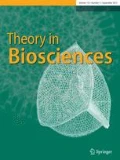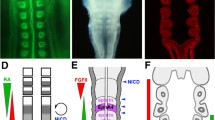Abstract
We present in vivo observations of chicken embryo development which show that the early chicken embryo presents a principal structure made out of concentric rings and a secondary structure composed of radial sectors. During development, physical forces deform the main rings into axially directed, antero-posterior tubes, while the sectors roll up to form cylinders that are perpendicular to the antero-posterior axis. As a consequence, the basic structure of the chicken embryo is a series of encased antero-posterior tubes (gut, neural tube, body envelope, amnion, chorion) decorated with smaller orifices (ear duct, eye stalk, nasal duct, gills, mouth) forming at right angles to the main body axis. We argue that the second-order divisions reflect the early pattern of cell cleavage, and that the transformation of radial and orthoradial lines into a body with sensory organs is a generic biophysical mechanism more general than the chicken embryo.
















Similar content being viewed by others
Notes
In rays, growth of a very wide pectoral flap along the Dorso-Ventral edge is a secondary process during embryogenesis.
The AP asymmetry in vertebrates stems from a polar distribution of vitellus in the oocyte, further amplified by the mechanism of sperm entry across the oocyte membrane. Here, we shall not discuss further this asymmetry.
Called blastodisc in the case of chicken.
The term archetype is referred as a different concept in the main text and in the glossary of Darwin’s Origin of species. In the main text, it is referred as the ancestral form, while in the glossary it is referred as: “ideal primitive form upon which all the beings of a group seem to be organised” (Darwin 1872).
References
Alisafaei F, Chen X, Leahy T, Janmey PA, Shenoy VB (2021) Long-range mechanical signaling in biological systems. Soft Matter 2
Asai R, Haneda Y, Seya D, Arima Y, Fukda K, Kurihara Y, Miyagawa-Tomita S, Kurihara H (2017) Amniogenic somatopleure: a novel origin of multiple cell lineages contributing to the cardiovascular system. Sci Rep 7:8955–8969
Baker CVH, Bronner-Fraser M (2001) Vertebrate cranial placodes I. Embryonic induction. Dev Biol 232:1–61
Besson S, Dumais J (2011) Universal rule for the symmetric division of plant cells. Proc Nat Acad Sci 108(15):6294–6299
Brodland GW, Chen DI-L, Veldhuis JH (2006) A cell-based constitutive model for embryonic epithelia and other planar aggregates of biological cell. Int J Plastic 22:965–995
Campas O, Mallarino R, Herrel A, Abzhanov A, Brenner MP (2010) Scaling and shear transformations capture beak shape variation in Darwin's finches. Proc Nat Acad Sci 107(8):3356–3360
Carvalho E, Lahaye F, Wen L, Yong, Croce JC, Escriv H, Yu J, Schubert M (2020) An updated staging system for cephalochordate development: one table suits them all. bioRxiv. https://doi.org/10.1101/2020.05.26.112193
d’Arcy Thomson W (1992) On growth and Form, revised edition. Dover, New York
Darwin C (1872) On the origin of species, 6th edn. https://www.gutenberg.org/files/2009/2009-h/2009-h.htm
Douady S, Couder Y (1992) Phyllotaxis as a self-organized growth process. Phys Rev Lett 68:2098–2101
Duboule D (1994) Guidebook to the Homeobox Genes. Oxford University Press, Oxford
Ermakov AS (2018) Professor Lev Beloussov and the birth of morphomechanics. Biosyst 173:26–35. https://doi.org/10.1016/j.biosystems.2018.10.010 (Epub 2018 Oct 10)
Etchevers H, Dupin E, Le Douarin N (2019) The diverse neural crest: from embryology to human pathology. Dev 146(5):dev169821
Farge E (2003) Mechanical induction of Twist in the Drosophila foregut/stomodeal primordium. Curr Biol 13:1365–1377
Fleury V (2005) An elasto-plastic model of Avian gastrulation. Organogenesis 2(1):6–16
Fleury V (2009) Clarifying tetrapod embryogenesis, a physicist’s point of view. Eu Phys J App Phys 45:30101–30155
Fleury V (2012) Clarifying tetrapod embryogenesis by a dorso-ventral analysis of the tissue flows during early stages of chicken development. Biosyst 109:460–474
Fleury V (2017) The Angel’s staircase: cell cycle, and the embryogenesis of vertebrates. Chaos Solitons Fractals 105:230–234
Fleury V, Murukutla AV (2019) Electrical stimulation of developmental forces reveals the mechanism of limb formation in vertebrate embryos. Eu Phys J E 42:104. https://doi.org/10.1140/epje/i2019-11869-8
Fleury V, Chevalier N, Furfaro F, Duband J-L (2015) Buckling along boundaries of elastic contrast as a mechanism for early vertebrate morphogenesis. Eu Phys J E 38(6):1–19
Fleury V, Murukutla AV, Chevalier AN, Gallois B, Capellazzi-Resta M, Picquet P, Peaucelle A (2016) Physics of amniote formation. Phys Rev E 94:022426–022444
Forgács G, Newman SA (2005) Biological physics of the developing embryo. Cambridge University Press, Cambridge
Gordon NK, Gordon R (2016) Embryogenesis explained. World Scientific, Singapore
Hamburger V, Hamilton HL (1951) A series of normal stages in the development of the chick embryo. J Morphol 88(1):49–92
His W (1874) Unsere Körperform und das physiologische Problem ihrer Entstehung. Briefe an einen befreundeten Naturforscher (Engelmann, Leipzig
Hopwood N (2015) Haeckel’s embryos: images, evolution, and fraud. University of Chicago Press, Chicago
Ingber DE (2003) Tensegrity I Cell structure and hierarchical systems biology. J Cell Sci 116:1157–1173. https://doi.org/10.1242/jcs.00359
Jordan LK (2008) Comparative morphology of stingray lateral line canal and electrosensory systems. J Morph 269(11):1325–1339
Keller R (2002) Shaping the vertebrate body plan by polarized embryonic cell movements. Science 298(5600):1950–1954. https://doi.org/10.1126/science.1079478
Le Noble F, Moyon D, Pardanaud L, Yuan L, Djonov V, Mattheijssen R, Bréant C, Fleury V, Eichmann A (2004) Flow regulates arterio-venous differentiation in the chick embryo yolk-sac. Dev 131:361–437
Leduc S (1912) La biologie synthétique, étude de biophysique. Poinat 1912
Lee HC, Choi HJ, Park TS, Lee SI, Kim YM, Rengaraj S, Nagai H, Sheng G, Lim JM, Han JY (2016) Cleavage events and sperm dynamics in chick intrauterine embryos. PLoS ONE 8(11):e80631
Louveaux M, Julien JD, Mirabe V, Boudaoud A, Hamant O (2016) Cell division plane orientation based on tensile stress in Arabidopsis thaliana. Proc Nat Acad Sci 113(30):E4294–E4303
Mao F, Hu Y, Li C, Wang Y, Chase MHA, Smith AK, Meng J (2020) Integrated hearing and chewing modules decoupled in a Cretaceous stem therian mammal. Sci 367(6475):305–308
Montévil M (2020) Historicity at the heart of biology. Theory Biosci
Nagai H, Sezaki M, Kakiguchi K, Nakaya Y, Lee HCh, Ladher R, Sasanami T, Han JY, Yonemura S, Sheng G (2015) Cellular analysis of cleavage-stage chick embryos reveals hidden conservation in vertebrate early development. Development 142:1279–1286
Newman S (2012) Physico-genetic determinants in the evolution of development. Science 338(6104):217–219
Nishida H (2005) Specification of embryonic axis and mosaic development in ascidians. Dev Dyn 233:1177–1193
Nüsslein-Volhard C, Wieschaus E (1980) Mutations affecting segment number and polarity in Drosophila. Nature 287(5785):795–801
Paluch EK, Nelson CM, Biais N, Fabry B, Moeller J, Pruitt BL, Wollnik C, Kudryasheva G, Rehfeldt F, Federle W (2015) Mechanotransduction: use the force(s). BMC Biol 13:47–61
Richardson MK, Hanken J, Gooneratne ML, Pieau C, Raynaud A, Selwood L, Wright GM (1997) There is no highly conserved embryonic stage in the vertebrates: implications for current theories of evolution and development. Anat Embryol 196:91–106
Rupke NA (1993) Richard Owen’s vertebrate archetype. Isis 84(2):21–255
Shah G, Thierbach K, Schmid B et al (2019) Multi-scale imaging and analysis identify pan-embryo cell dynamics of germ layer formation in zebrafish. Nature Comm 10:5753
Théry M, Racine V, Pépin A, Piel M, Chen Y, Bornens M (2005) The extracellular matrix guides the orientation of the cell division axis. Nat Cell Biol 7(10):947–953
Tipping N, Wilson D (2011) Chick Amniogenesis is mediated by an actin cable. Anat Rec (Hoboken) 294(7):1143–1149
Turing AM (1952) The chemical basis of morphogenesis. Phil Trans Roy Soc London B 237(641):37–72
Valentine JW (1997) Cleavage patterns and the topology of the metazoan tree of life. PNAS 94(15):8001–8005
Varner VD, Voronov DA, Taber LA (2010) Mechanics of head fold formation: investigating tissue-level forces during early development. Development 137(22):3801–3811
von Baer KE (1828) Über Entwickelungsgeschichte der Thiere. Ludwig Stieda, Königsberg
Wilson EB (1928) The cell and development in heredity, 3rd edn. Macmillan, New York
Acknowledgements
We thank Nicolas Chevalier for his interest and support and for a careful reading of the manuscript. We thank an anonymous reviewer for constructive remarks and relevant references.
Author information
Authors and Affiliations
Corresponding author
Additional information
Publisher's Note
Springer Nature remains neutral with regard to jurisdictional claims in published maps and institutional affiliations.
Supplementary Information
Below is the link to the electronic supplementary material.
Supplementary file1 (AVI 20513 kb)
Supplementary file2 (AVI 5256 kb)
Supplementary file3 (AVI 39133 kb)
Supplementary file4 (AVI 32073 kb)
Supplementary file5 (AVI 9245 kb)
Supplementary file6 (AVI 33415 kb)
Supplementary file7 (AVI 31421 kb)
Supplementary file8 (AVI 6544 kb)
Supplementary file9 (AVI 17231 kb)
Supplementary file10 (AVI 16268 kb)
Supplementary file11 (AVI 15710 kb)
Supplementary file12 (AVI 13350 kb)
Supplementary file13 (AVI 33635 kb)
Supplementary file14 (AVI 16505 kb)
Supplementary file15 (AVI 16001 kb)
Supplementary file16 (AVI 8004 kb)
Supplementary file17 (AVI 13730 kb)
Supplementary file18 (AVI 18558 kb)
Supplementary file19 (AVI 22505 kb)
Supplementary file20 (AVI 18185 kb)
Supplementary file21 (AVI 1306 kb)
Supplementary file22 (AVI 6884 kb)
Supplementary file23 (AVI 8222 kb)
Rights and permissions
About this article
Cite this article
Fleury, V., Peaucelle, A., Abourachid, A. et al. Second-order division in sectors as a prepattern for sensory organs in vertebrate development. Theory Biosci. 141, 141–163 (2022). https://doi.org/10.1007/s12064-021-00350-w
Received:
Accepted:
Published:
Issue Date:
DOI: https://doi.org/10.1007/s12064-021-00350-w




